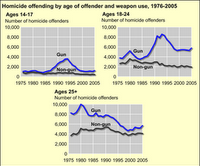 via criminal defense attorney jeralyn merritt:
via criminal defense attorney jeralyn merritt:
richard crawford, a communications prof and past president of the american society of trial consultants, lists his top ten myths about jury trials in today’s rocky mountain news.
1. Your only chance as a defendant is to have lots of money.
This is largely false, primarily because as many as 80 percent of those charged with a crime are rigorously defended by public defenders or court-appointed attorneys. Believe it or not, if you have just enough money to hire your own trial lawyer, you might end up with a less effective defense lawyer than if you had very little money and were lucky enough to live in Colorado and receive representation from a career and free public defender.
2. Innocence will protect you in a criminal trial.
Regrettably, this is usually not the case. Specifically, for anyone who faces a jury, there is roughly an 85 percent chance that the trial will end up with a conviction. Tim Masters just might have something to say on this subject. Studies indicate that from 7 percent to 10 percent of those in prison today are actually innocent persons who got caught in this process.
3. Lawyers prefer jurors with little formal education.
The answer here is that it depends. There are instances like the recent Nacchio case when the issues are sufficiently complicated that both sides prefer very bright jurors. And, yes, there are other instances when the defendant is a barroom fighter of sorts and the defense would prefer to have jurors just like him who can identify with him.
4. Defendants should always take the stand in their own defense.
While all defendants have the absolute right to testify on their own behalf, frequently they do not exercise that right. And there is no doubt but that jurors often reason: “If he didn’t do it, why doesn’t he take the stand and say so?” On the other hand, there is a long list of very good reasons why a particular defendant should say nothing during his or her trial. For example, an innocent defendant may have once been convicted of a felony and the jury would learn that prejudicial fact only if that defendant decided to testify.
5. Juries sometimes find defendants innocent.
No, this cannot happen anywhere in these United States. “Guilty” or “not guilty” are the only two options open to an American jury. Sometimes juries believe that a defendant committed the act as charged, but that it was not proved beyond a reasonable doubt by the state, so they vote “not guilty” as a way of saying, “not proved.” Sometimes juries think a defendant did not commit any crime and they vote “not guilty,” meaning “innocent.”
6. Defense lawyers who defend those they know to be guilty are unethical.
No, a person charged with a crime is never guilty unless and until a jury has said so and a judge has affirmed same. Our Constitution guarantees everyone the right to a vigorous defense or testing of the evidence and it would actually be illegal and unethical if a defendant were denied this right.
7. A trial is about discovering the truth.
No, the truth may be that a good young man broke the law when he went for the first time with a group who committed a robbery. But Justice might say he should get another chance. The truth may be that a wife killed her violent husband, but Justice might say she should not give up her freedom for that act. Trials are always about Justice and the truth may be a part of getting there, but Justice is the goal.
8. Jurors deliberate in the classic sense until they reach their final verdict.
The requirement for a unanimous verdict means that jurors usually only deliberate during the first stages of their time together. Ninety percent of the time, the majority overcomes the minority in order to get that unanimous verdict. Make no mistake about it, eight or nine jurors can and do exert enormous pressure on three or four holdouts to get a verdict that will wrap it up and get everyone home.
9. Evidence drives the outcome of jury verdicts.
Actually, when the evidence on either side of a case is overwhelming, a verdict can be pretty predictable. The reality is, however, that deals are almost always struck when one side or the other has a huge evidence advantage. Thus, since a majority of trials could go either way, the final verdict is often determined by nonevidentiary factors. Two such factors include the quality of the lawyers and the pro-conviction predisposition of most jurors.
10. When a jury votes guilty, that is final.
No verdict is ever final until the judge says so. In fact, although it is rare, the trial judge can set aside a guilty verdict with the tap of his or her gavel. Of course, any guilty verdict can also be appealed to a higher court.
 i got up early to take my class to a youth correctional facility today. we drove through grant hart-land and ended up by greg norton’s restaurant. feeling nostalgic over my favorite band’s breakup, i stumbled on a blog tribute and mp3 to 2541, mr. hart’s ode to love and the band’s old address.
i got up early to take my class to a youth correctional facility today. we drove through grant hart-land and ended up by greg norton’s restaurant. feeling nostalgic over my favorite band’s breakup, i stumbled on a blog tribute and mp3 to 2541, mr. hart’s ode to love and the band’s old address.






